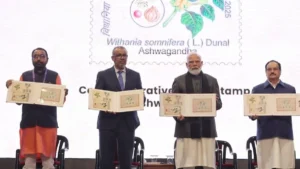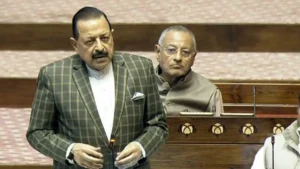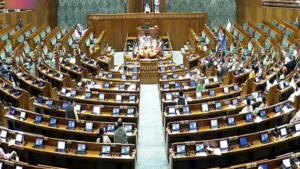The Kartarpur Sahib Corridor, connecting India and Pakistan, marks its fifth anniversary today. The corridor leads to the Gurdwara Sri Kartarpur Sahib in Pakistan, where Guru Nanak Dev Ji spent the last 18 years of his life. The corridor was inaugurated by Indian Prime Minister Narendra Modi on November 9, 2019, during the 550th Prakash Purb of Guru Nanak Dev Ji. Over the past five years, more than 3.4 lakh devotees have visited the site. The corridor is a significant step in religious diplomacy, allowing pilgrims from India to visit this sacred site without a visa. As of today, 417 pilgrims have traveled, the highest this year.
Kartarpur: A Historic and Religious Site
Kartarpur, founded by Guru Nanak in 1504 CE, holds great significance in Sikhism as it was the site of the first Sikh commune on the right bank of the Ravi River. After Guru Nanak’s death in 1539, both Hindus and Muslims claimed him as their own and erected mausoleums in his memory, which were eventually washed away due to the changing course of the Ravi River. Present-day Dera Baba Nanak, located on the left bank of the Ravi, marks the place where a new settlement emerged.
Partition and Division of Kartarpur
The partition of India in 1947 led to the division of the region between India and Pakistan. According to the Radcliffe Line, Kartarpur and the surrounding area on the right bank of the Ravi River were allocated to Pakistan, while the left bank, including Dera Baba Nanak, became part of India. Following the partition, the Akali Dal in India pushed for the acquisition of lands associated with key Sikh shrines, including Kartarpur, though this was not pursued by the Indian government, which was then under the Indian National Congress.
Pre-1965 Crossings and the 1965 War
Before strict border controls were implemented, Indian Sikhs could visit Kartarpur informally by crossing the Jassar Bridge, which spanned the Ravi River. This continued until 1965 when the bridge was destroyed during the Indo-Pakistan war, and border controls became more stringent. The break in informal visits marked a significant disruption for Sikhs wishing to access this holy site.
Efforts for Kartarpur’s Re-integration into India
In 1969, during the 500th birth anniversary of Guru Nanak, Indian Prime Minister Indira Gandhi expressed interest in negotiating a land-swap with Pakistan to bring Kartarpur under India’s control. However, this effort never materialized. Later, in 1974, a protocol between India and Pakistan allowed for visits to religious shrines, but Kartarpur was not included despite Indian requests. The issue remained unresolved for decades, despite several diplomatic efforts.
The Gurdwara’s Decline and Restoration
For many years after the partition, the Kartarpur Gurdwara remained in disrepair. From 1947 to 2000, it was abandoned and even used as a cattle shed by local villagers. The Pakistani government began repairs in 2000 ahead of Guru Nanak’s death anniversary and formally reopened the gurdwara in 2004. Prior to this, the site was largely ignored, with no official staff or regular visitors, despite being a place of pilgrimage.
The Kartarpur Corridor Initiative
The Kartarpur Corridor project began in earnest with Bhabishan Singh Goraya, who campaigned for 24 years to reopen and maintain the shrine. Since 2003, the Pakistani government has taken measures to preserve Sikh religious sites, including Kartarpur, though the gurdwara had been neglected for much of the post-partition period. The Kartarpur Corridor remains a symbol of the shared religious heritage of India and Pakistan and continues to be an important focal point for Sikh pilgrims.
Historical Significance of Kartarpur Corridor
The Kartarpur Corridor allows Indian Sikh pilgrims to visit the Gurdwara Darbar Sahib in Pakistan, located just 4.7 kilometers from the border. The corridor’s idea was first proposed in 1999 and completed in 2019, offering a visa-free crossing for Indian devotees. The corridor was initially part of confidence-building measures between India and Pakistan, and it has survived political tensions. Despite the historical context of India and Pakistan’s separation in 1947, the corridor has become a beacon of hope for Sikh religious pilgrims, fostering greater understanding and peace between the two countries.
India and Pakistan Renew Kartarpur Agreement
In October 2024, India and Pakistan renewed their agreement to operate the Kartarpur Corridor for another five years. This renewal came after an earlier visit by India’s External Affairs Minister S. Jaishankar to Pakistan for the SCO meet. India has urged Pakistan to waive the $20 service charge for pilgrims, which continues to be a point of discussion. Despite challenges in bilateral relations, the corridor serves as a vital symbol of religious cooperation between the two nations.
Summery of the News
| Why in News | Key Points |
|---|---|
| Kartarpur Corridor | The Kartarpur Corridor was opened for Indian Sikhs to visit Kartarpur Gurdwara in Pakistan without visas. |
| Historical Context | Founded by Guru Nanak in 1504 CE on the right bank of the Ravi River. |
| Partition Impact (1947) | After Partition, Kartarpur was divided between India (left bank) and Pakistan (right bank). |
| Indira Gandhi’s Promise (1969) | Prime Minister Indira Gandhi promised to negotiate for a land-swap during Guru Nanak’s 500th birth anniversary. |
| Jassar Bridge Destruction (1965) | The bridge was destroyed during the Indo-Pakistan war, restricting Indian access to Kartarpur. |
| Reopening of Kartarpur Gurdwara (2004) | Pakistan reopened the gurdwara in 2004 after extensive repairs. |
| Bhabishan Singh Goraya’s Role | Played a key role in advocating for the Kartarpur Corridor for 24 years. |
| India-Pakistan Protocol (1974) | Protocol for visits to religious sites between India and Pakistan but Kartarpur was not included. |
| Key Political Figures | Akali Dal demanded the acquisition of Kartarpur land post-Partition. |
| Geography | Kartarpur is located in Pakistan, on the right bank of the Ravi River in Shakargarh tehsil, near the India-Pakistan border. |
| Gurdwara Significance | Kartarpur Gurdwara is an important religious site for Sikhs as it was founded by Guru Nanak. |
| Border and Access | Kartarpur is situated on the Pakistan side, with restricted access for Indian Sikhs due to the border control after 1947. |
| Religious Restoration | Pakistani government initiated restoration and maintenance of Sikh religious shrines, including Kartarpur, since 2003. |




 Prime Minister Releases Commemorative Po...
Prime Minister Releases Commemorative Po...
 Parliament Passes SHANTI Bill, AERB Gets...
Parliament Passes SHANTI Bill, AERB Gets...
 Viksit Bharat G RAM G Bill Passed in Lo...
Viksit Bharat G RAM G Bill Passed in Lo...







